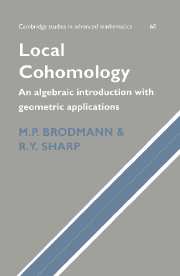Book contents
- Frontmatter
- Contents
- Dedication
- Preface
- Notation and conventions
- 1 The local cohomology functors
- 2 Torsion modules and ideal transforms
- 3 The Mayer-Vietoris Sequence
- 4 Change of rings
- 5 Other approaches
- 6 Fundamental vanishing theorems
- 7 Artinian local cohomology modules
- 8 The Lichtenbaum-Hartshorne Theorem
- 9 The Annihilator and Finiteness Theorems
- 10 Matlis duality
- 11 Local duality
- 12 Foundations in the graded case
- 13 Graded versions of basic theorems
- 14 Links with projective varieties
- 15 Castelnuovo regularity
- 16 Bounds of diagonal type
- 17 Hilbert polynomials
- 18 Applications to reductions of ideals
- 19 Connectivity in algebraic varieties
- 20 Links with sheaf cohomology
- Bibliography
- Index
18 - Applications to reductions of ideals
Published online by Cambridge University Press: 04 May 2010
- Frontmatter
- Contents
- Dedication
- Preface
- Notation and conventions
- 1 The local cohomology functors
- 2 Torsion modules and ideal transforms
- 3 The Mayer-Vietoris Sequence
- 4 Change of rings
- 5 Other approaches
- 6 Fundamental vanishing theorems
- 7 Artinian local cohomology modules
- 8 The Lichtenbaum-Hartshorne Theorem
- 9 The Annihilator and Finiteness Theorems
- 10 Matlis duality
- 11 Local duality
- 12 Foundations in the graded case
- 13 Graded versions of basic theorems
- 14 Links with projective varieties
- 15 Castelnuovo regularity
- 16 Bounds of diagonal type
- 17 Hilbert polynomials
- 18 Applications to reductions of ideals
- 19 Connectivity in algebraic varieties
- 20 Links with sheaf cohomology
- Bibliography
- Index
Summary
In recent years, graded local cohomology theory has played a substantial role in the study of Rees rings and associated graded rings of proper ideals in local rings. We do not have enough space in this book to include all we would like about the applications of local cohomology to this area, and so we have decided to select a small portion of the theory which gives some idea of the flavour. The part we have chosen to present in this chapter concerns links between the theory of reductions of ideals in local rings and the concept of Castelnuovo regularity, discussed in Chapter 15. The highlight will be a theorem of L. T. Hoa which asserts that, if b is a proper ideal in a local ring having infinite residue field, then there exist t0 ∈ ℕ and c ∈ ℕ0 such that, for all t > t0 and every minimal reduction a of bt the reduction number ra(bt) of bt with respect to a is equal to c. This statement of Hoa's Theorem is satisfyingly simple, and makes no mention of local cohomology, and yet Hoa's proof, which we present towards the end of this chapter, makes significant use of graded local cohomology.
Reductions and integral closures
Reductions of ideals of local rings were first considered by D. G. Northcott and D. Rees in [45]. Nowadays, the concept is recognized as being of major importance in commutative algebra.
- Type
- Chapter
- Information
- Local CohomologyAn Algebraic Introduction with Geometric Applications, pp. 325 - 341Publisher: Cambridge University PressPrint publication year: 1998



